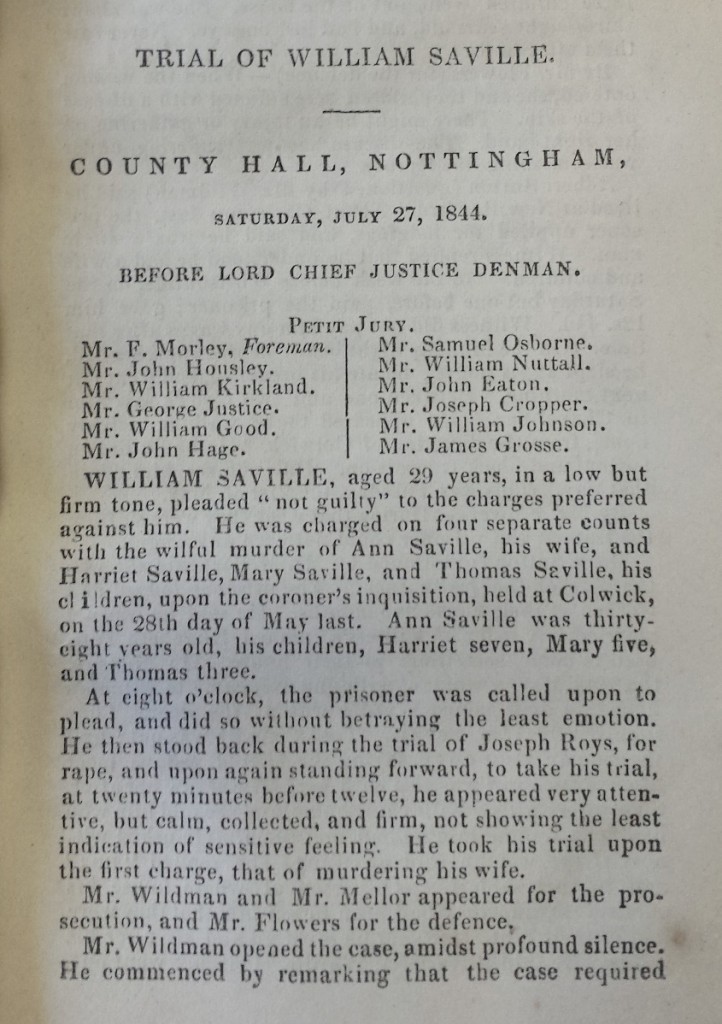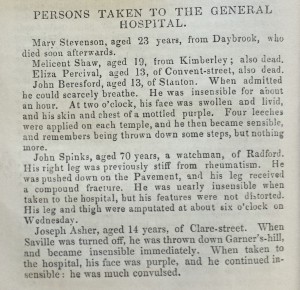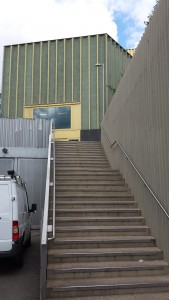August 7, 2016, by Kathryn Steenson
Mr William Saville’s Crime
William Saville (1815-1844) is not a resident that Nottingham, or any other city, would boast about. The child of a violent drunkard who grew up to become a murderer would have been little more than a footnote in Nottingham’s history had it not been for the terrible events at his execution.
 The whole story is told in the 1844 pamphlet “Some particulars of the life, trial, behaviour, and execution of William Saville, for the wilful murder of his wife and three children: with a full account of the fatal accident at the execution” (Ref: EMSC Not 3.H64 SAV). Much of it is taken from local newspaper reports and includes the trial report, a biography, Saville’s confession, a report of his execution and subsequent tragedy, and a list of the dead and wounded including some excerpts from the inquests.
The whole story is told in the 1844 pamphlet “Some particulars of the life, trial, behaviour, and execution of William Saville, for the wilful murder of his wife and three children: with a full account of the fatal accident at the execution” (Ref: EMSC Not 3.H64 SAV). Much of it is taken from local newspaper reports and includes the trial report, a biography, Saville’s confession, a report of his execution and subsequent tragedy, and a list of the dead and wounded including some excerpts from the inquests.
As the pamphlet’s title makes clear, Saville was convicted of murdering his wife Ann (aged 38) and their children Harriet (7), Mary (5) and Thomas (3) on 21st May 1844.
Ann was not considered a ‘good’ catch. Ten years older than Saville and missing an eye, she had already had one illegitimate child by another man when she fell pregnant by Saville, who wasn’t held in high regard by the community either. Social pressure and the promise of a house from her relatives persuaded them to marry. From the outset Saville was an abusive tyrant. Ann reportedly said the happiest she had been during her marriage was when her husband was imprisoned for theft.
At the time of the murder, Ann and the children were in Nottingham Workhouse. Saville sent weekly parcels of tea and sugar, either as his way of supporting his family, or to buy Ann’s silence. He found employment as a stocking weaver and began a relationship with a young lady.
The jury believed that his often-expressed desire to marry her was sincere. That was his motive for luring his inconvenient family to Colwick Wood and slitting their throats with a razor, which he then placed in his wife’s hand to frame her.
The case was reported nationally and gripped the public imagination. Hundreds visited the site of the murders, rather gruesomely named by locals ‘Saville’s Spinney’, to take twigs and leaves as souvenirs.
Court reports described him as 5 ft 6 inches tall with thinning dark hair and a sallow complexion. His calm demeanour did not befit a murderer, but the pamphlet thoroughly outlines the evidence against him: witnesses who saw all five heading to the woods; neighbours and colleagues who attested to his temper and dishonesty; and physicians who examined the bodies and testified that Ann could not be responsible for either the neck wounds or the bloody handprint on her clothing.
The jury convicted Saville after 18 minutes’ deliberation. He was sentenced to hang outside the Shire Hall on High Pavement at 8am on 7th August. Tens of thousands turned out to watch, but the larger than usual crowd did not alarm the authorities, who were used to public executions passing uneventfully (except for the condemned). This lackadaisical attitude to public safety was officially blamed for what happened by the inquest jury, who believed the authorities should have realised that a surge of people all trying to leave at once through the narrow streets was a crush waiting to happen.
It finally happened on that August morning, shortly after Saville was pronounced dead. The occupants of buildings along the route opened doors and windows to relieve the pressure on those crushed against walls and attempts were made to alert those at the back to slow down. People were trampled underfoot as the momentum pushed people along. As the head of the crowd entered the narrow steps of Garners Hill, leading to Narrow Marsh, someone slipped, and people started tumbling down the steps.
Twelve people died at the scene and several more succumbed to their injuries over the following weeks. Many more were hurt, suffering from crushing, bruising and broken bones. The youngest victim was 9-year old Thomas Easthorpe, killed alongside his older sister Mary. The oldest was a watchman aged 70, John Spinks, who lingered several days after having his thigh amputated.
The most striking fact is that the majority of the dead were barely into their teens. They had been given permission to go to the execution by their family or employers. In our modern society where audiences have to be at least 15 to see strong fictional violence in a film, it is shocking that a hanging was considered a suitable and fun entertainment for a 9-year old.
There were two other public executions in Nottingham before the practice was outlawed in 1868, both much more organised than Saville’s hanging. Were it not for the crush, Saville’s crime would have vanished from memory as much as it has from the physical landscape. Houses were built on Saville’s Spinney in the 20th century. The Shire Hall is now the Galleries of Justice Museum. Today the steps of Garners Hill, which run beside Nottingham Contemporary to a car park, are wide and well-maintained. There is nothing to indicate the events of 1844.



i truly believe that william saville was made an escape goat and dont believe for one minute that william was the one who killed the poor children, yes i agree he killed his wife but i feel this would have been purely a reaction to the dreadful act of seeing his children murdered and would really like to not clear his name per say but give some sort of vindication to his actions which would change peoples view. instead of being known as a cold blooded killer but instead a father who loved his children. i have read around this for many years now because of a family connection and feel the evidence speaks for itself . thank you
Saville was not tried or convicted for the murder of his children, only his wife. The surgeons post-mortem report indicated two different murder techniques indicating two different murderers. Saville’s own confession stated that he returned from “making water” to find his wife holding his youngest child his son between her legs and drawing a razor across his throat so killing him. Enraged Saville then took the razor off his wife then cut her throat with it. As he did so his two daughters returned from picking flowers and witnessed this second murder. They both started screaming so Saville decided he had to kill them both to silence them and both had their throats cut. The worst injuries were suffered by his eldest child Harriet. Very likely to be the last to die she was the only one to have any defensive injuries, a cut across a thumb maybe as she held a hand up to protect herself. Also a contusion or bruise on her face. She was very nearby decapitated as the razor almost cut through one of her vertebrae. I spent months researching this event in Nottingham Library and have written a very complete account in my book SAVILLES SPINNEY . It’s on Amazon and everybody can read the first few chapters free of charge,
Mike Sheridan